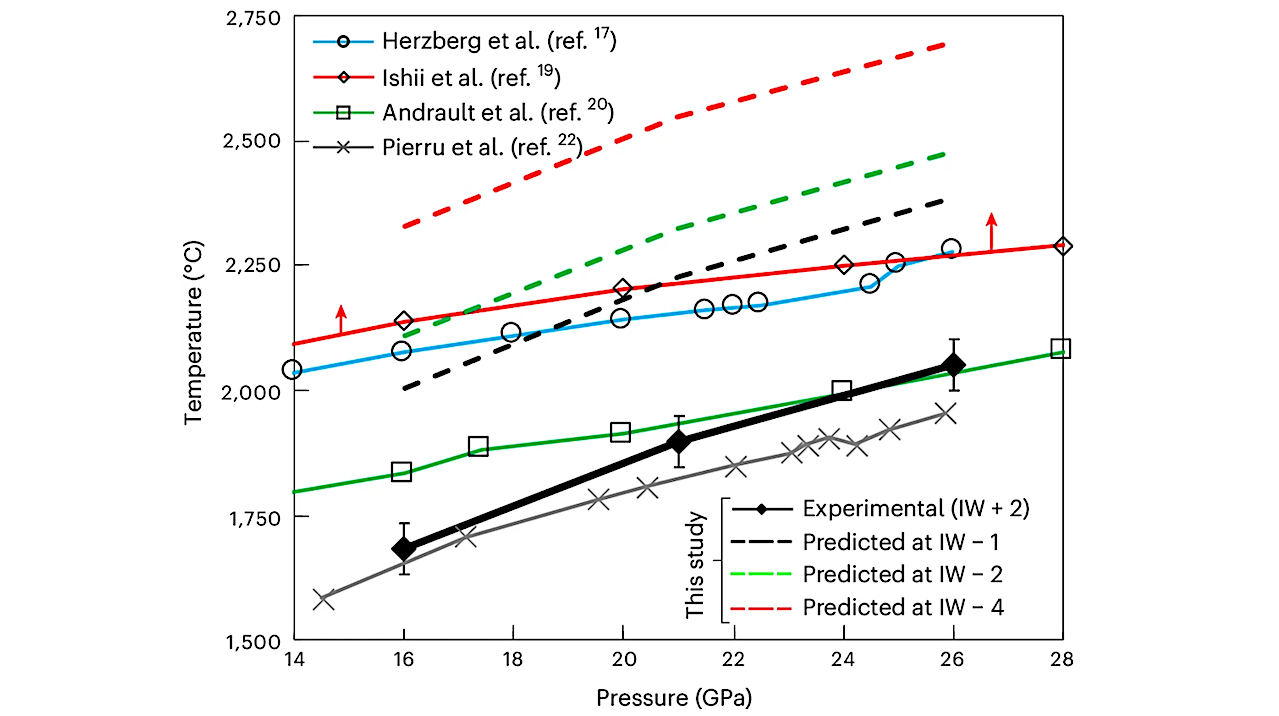
Closed diamonds: this study (pyrolite composition at fO2 = IW + 2.0), including uncertainties of ±50 °C (described in the note to Table 1); Open diamonds: Ishii et al.19 (minimum solidification temperature, indicated by red arrows, for pyrolite composition at estimated IW − 1.2); Open circles: Herzberg et al.17 (KLB-1 peridotite composition, estimated IW – 1.2); Open squares: Andrault et al.20 (chondritic mantle composition, oxygen fugacity not determined but higher oxygenation than IW – 1.2); crosses: Pierru et al.22 (pyrolytic mantle composition, oxygen fugacity estimated at about IW + 2). All data are presented as mean values with ± standard errors (when the latter is provided by the authors; raw data Fig. 1). Dashed lines show predicted solids at fO2 levels implemented in siderophile element-based core formation models (IW – 1, IW – 2 and IW – 4) based on Equation (1). – Okayama University
It is widely accepted that the beginning of the Earth consisted mostly of molten magma, creating a global ocean of magma. This extreme state of the Earth may have been caused by intense heat generated from accretion impacts, which represent small celestial bodies colliding with the Earth.
Understanding the formation of this magma ocean is critical to understanding the formation of Earth. A major problem with current magma ocean formation models is the lack of consensus on the melting temperature of deep mantle rocks. Models that explain the formation of the Earth’s core use a certain experimental data to estimate the melting temperature of the mantle, but recent experiments show that these temperatures can differ from previously accepted data by 200-250 ° C.
Some studies suggest that oxygen fugacity, or the amount of oxygen available in the mantle, can strongly influence the melting temperature of deep mantle rocks, which may have influenced the formation of magma oceans. Mantle oxygen fugacity is thought to have increased during accretion, core formation, and subsequent mantle evolution; However, the effect of this increase on the melting temperature of deep mantle materials remains unclear.
To address this gap, a team of researchers led by Associate Professor Takayuki Ishii from the Institute of Planetary Materials at Okayama University in Japan and Dr. Yanhao Lin from the Advanced Research Center for High Pressure Science and Technology of China investigated the effects of oxygen fugacity. Magma ocean formation during early Earth evolution.
„The evolution of the early Earth was strongly influenced by oxygen fugacity, which may require a revision of current models. To this end, we evaluated the effect of oxygen fugacity on the melting temperature of deep mantle materials to constrain the conditions on the floor of the deep terrestrial magma ocean,” explains Professor Ishii.
The study was led by Prof. Wim van Westrenen from the Department of Earth Sciences, Faculty of Science at the Vrije Universiteit Amsterdam in the Netherlands, Prof. Tomoo Katsura from the Bayerisches Geoinstitut of the University of Bayreuth, Germany, and Dr. from the Center. Ho-Kwang Mao is also involved. High Pressure Science and Technology Advanced Research, China. It was published online July 16, 2024 in the journal Nature Geoscience.
The researchers conducted melting experiments on mantle pyrolite, a material that characterizes the Earth’s mantle, at pressures of 16–26 gigapascals and high oxygen fugacities, similar to mantle depths of 470 km to 720 km. The results revealed that in this pressure range, the melting temperatures decreased with increasing oxygen fugacity and were at least 230–450°C lower than the experiments conducted at lower oxygen fugacities.
Assuming a constant temperature for the magma ocean, this implies that the magma ocean floor deepens by about 60 km for each logarithmic unit increase in mantle oxygen fugacity. This strong influence of oxygen fugacity on mantle melting suggests that current models for early Earth thermal evolution and core formation require reevaluation.
Furthermore, these results may also explain the apparent discrepancy between high oxygen fugacities produced by deep mantle melting observed in Earth’s deep mantle post-core formation and magmatic rocks older than 3 billion years.
„Beyond the formation of Earth, our findings about the melting temperature dependence of oxygen fugacity can also be used to understand the formation of other rocky planets that could support human life,” said Dr. Lin highlighted the potential impact of the study. He adds, „For example, these results could improve our understanding of Mars, a recent hot topic related to human habitability.”
This exciting study promises to improve models of Earth formation, deepening our understanding of the formation of Earth and other planets.
About Okayama University, Japan
As one of the leading universities in Japan, Okayama University aims to create and establish a new paradigm for sustainable development in the world. Okayama University offers a wide range of academic disciplines, forming the basis of the integrated graduate schools. It not only allows for the conduct of highly advanced and up-to-date research, but also provides a rich educational experience.
Website: https://www.okayama-u.ac.jp/index_e.html
Terrestrial magma melts on the ocean floor controlled by oxygen fugacityNatural Geosciences (Open Access)
astronomy,

„Oddany rozwiązywacz problemów. Przyjazny hipsterom praktykant bekonu. Miłośnik kawy. Nieuleczalny introwertyk. Student.
